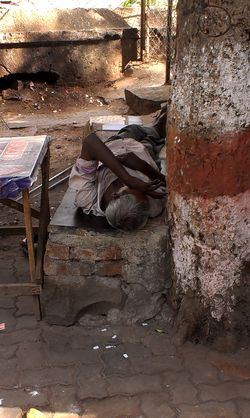by Gautam Pemmaraju
The hot summer months of April and May allow for some indolence. Slack jawed, enervated street dogs, seem somehow to be the most suffering. If their parched tongues say it all, their blinking eyes, bereft of the sharp darting aggression of cooler nights, seem to offer urgent supplication. In part alleviation, they sleep through whole afternoons in the reasonable comfort of a shady spot, on occassion lifting up their heat-stricken heads to cast a listless, impecunious glance at the fools who walk the hot streets. 
Offering vivid descriptions of city life, the hustle-bustle, street hawkers and dwellers, SM Edwardes, in By-Ways Of Bombay (1912), writes,
During the hot months of the year the closeness of the rooms and the attacks of mosquitoes force many a respectable householder to shoulder his bedding and join the great army of street-sleepers, who crowd the footpaths and open spaces like shrouded corpses. All sorts and conditions of men thus take their night's rest beneath the moon,–Rangaris, Kasais, bakers, beggars, wanderers, and artisans,–the householder taking up a small position on the flags near his house, the younger and unmarried men wandering further afield to the nearest open space, but all lying with their head towards the north for fear of the anger of the Kutb or Pole star.
In Sleepy Sketches (1877), the diarist, troubled by the ‘endless accounts’ of Englishmen of privilege and high office, which he finds to ill represent the reality of Bombay life (and life in Bombay), sets out to correct some. Asserting quite vigorously at the outset that the native has ‘no prejudice either in favour of truth or falsehood’ and that they cannot but help mixing the two, he finds issue with “hot glare of the sun and constant heat”, which to his mind “destroy the mystery of life and lead one to look on death as the end of all things” [sic]. The climate threatens the European, the writer adds, and it is so enervating for the professional man, that upon return home at the end of a hardworking day “we have little desire for recreation, and so no recreation is to be found”. The month of May, he writes on,
…brings thirty-one days of close, oppressive heat, and thirty-one nights of close, oppressive heat…when all possibility of sound sleep is gone, and we wake every hour and minute wet with perspiration; when even the crows have lost every power but that of cawing, – a power, confound them! that they never lose, – and stand desolate, with their hot wings held comically apart from their hot bodies…but still in Bombay we go to bed with the thermometer at 89°.
Read more »
